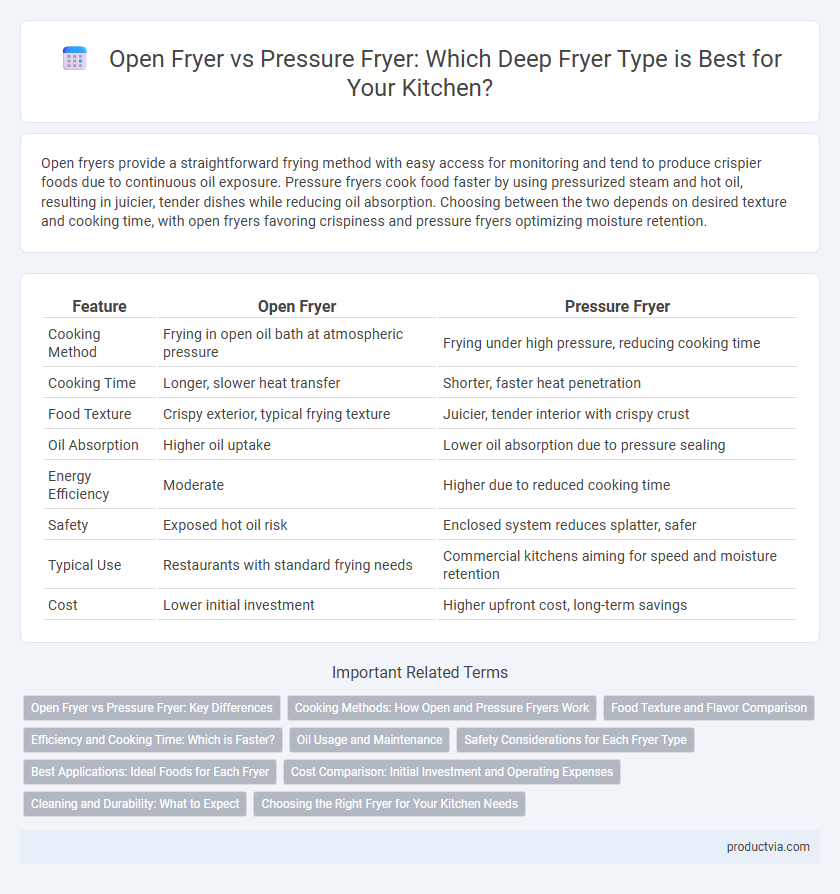Open fryers provide a straightforward frying method with easy access for monitoring and tend to produce crispier foods due to continuous oil exposure. Pressure fryers cook food faster by using pressurized steam and hot oil, resulting in juicier, tender dishes while reducing oil absorption. Choosing between the two depends on desired texture and cooking time, with open fryers favoring crispiness and pressure fryers optimizing moisture retention.
Table of Comparison
| Feature | Open Fryer | Pressure Fryer |
|---|---|---|
| Cooking Method | Frying in open oil bath at atmospheric pressure | Frying under high pressure, reducing cooking time |
| Cooking Time | Longer, slower heat transfer | Shorter, faster heat penetration |
| Food Texture | Crispy exterior, typical frying texture | Juicier, tender interior with crispy crust |
| Oil Absorption | Higher oil uptake | Lower oil absorption due to pressure sealing |
| Energy Efficiency | Moderate | Higher due to reduced cooking time |
| Safety | Exposed hot oil risk | Enclosed system reduces splatter, safer |
| Typical Use | Restaurants with standard frying needs | Commercial kitchens aiming for speed and moisture retention |
| Cost | Lower initial investment | Higher upfront cost, long-term savings |
Open Fryer vs Pressure Fryer: Key Differences
Open fryers operate by immersing food in hot oil at atmospheric pressure, allowing easy monitoring and quick cooking times, ideal for smaller batch frying. Pressure fryers cook food by combining high temperature oil with pressurized steam, resulting in faster cooking, moisture retention, and a crispier texture, making them preferred for high-volume commercial use. Key differences include cooking speed, texture quality, oil absorption, and energy efficiency, with pressure fryers offering enhanced flavor and reduced oil usage compared to open fryers.
Cooking Methods: How Open and Pressure Fryers Work
Open fryers cook food by submerging it in hot oil at atmospheric pressure, allowing moisture to evaporate freely and producing a crisp texture. Pressure fryers seal the cooking chamber, increasing pressure and temperature to cook food faster while retaining moisture, resulting in juicier, tender outcomes. The choice between these methods impacts cooking time, texture, and oil absorption significantly in commercial and home deep frying.
Food Texture and Flavor Comparison
Open fryers produce food with a crispier texture and lighter flavor due to frying at atmospheric pressure, allowing moisture to escape freely and creating a traditional fried finish. Pressure fryers cook food faster with sealed high pressure, resulting in juicier interiors and more intense, robust flavors as steam retains moisture and infuses seasoning. The choice between open and pressure frying significantly impacts the final food texture and flavor profile, with open fryers favoring crispness and pressure fryers emphasizing tenderness and flavor depth.
Efficiency and Cooking Time: Which is Faster?
Open fryers offer simplicity and faster heat-up times, making them efficient for quick, small-batch frying, while pressure fryers use sealed environments to trap heat and moisture, significantly reducing cooking times and enhancing food tenderness. Pressure frying typically cooks items 25-50% faster than open frying due to higher internal pressure and temperature, improving overall kitchen efficiency. For high-volume operations seeking speed and consistent results, pressure fryers provide superior efficiency compared to open fryers.
Oil Usage and Maintenance
Open fryers generally consume more oil due to continuous exposure to air, causing faster oil degradation and requiring more frequent oil changes. Pressure fryers maintain oil quality longer by sealing the cooking environment, reducing oil oxidation and extending its usability. Maintenance for open fryers involves regular oil filtering and more frequent replenishment, while pressure fryers demand thorough gasket and seal inspections to maintain proper pressure and ensure safety.
Safety Considerations for Each Fryer Type
Open fryers operate at lower pressures, reducing explosion risk but increasing the chance of hot oil splashes and burns, necessitating splash guards and careful monitoring. Pressure fryers seal the cooking environment, minimizing oil splatter and reducing fire hazards, but require regular maintenance of pressure valves and secure lids to prevent dangerous steam release or pressure build-up. Proper training and adherence to safety protocols are critical for both fryer types to prevent accidents and ensure safe operation in commercial kitchens.
Best Applications: Ideal Foods for Each Fryer
Open fryers are best suited for foods like French fries, onion rings, and battered fish, offering a crispy texture through traditional frying techniques. Pressure fryers excel at cooking chicken wings, fried chicken, and other meats, sealing in moisture while achieving a tender interior and crispy exterior. Choosing the right fryer depends on desired food texture and cooking efficiency for specific menu items.
Cost Comparison: Initial Investment and Operating Expenses
Open fryers generally require a lower initial investment, making them more accessible for small-scale operations, while pressure fryers tend to have higher upfront costs due to advanced features and construction. Operating expenses for pressure fryers are often reduced because they cook food faster and use less oil, leading to savings in energy and oil consumption over time. However, maintenance and repair costs for pressure fryers can be higher compared to open fryers due to their complex mechanisms.
Cleaning and Durability: What to Expect
Open fryers typically offer easier cleaning due to their straightforward design, allowing quick access to the frying basket and oil reservoir. Pressure fryers, while more complex, require diligent maintenance to ensure seals and pressure components remain intact, contributing to longer equipment lifespan. Durability in pressure fryers often surpasses open fryers because of robust construction designed to withstand high pressures and temperatures.
Choosing the Right Fryer for Your Kitchen Needs
Open fryers offer straightforward operation and easy maintenance, ideal for kitchens requiring quick frying with minimal equipment complexity. Pressure fryers cook food faster and retain moisture better, making them suitable for high-volume kitchens focused on consistent quality and juicy results. Selecting the right fryer depends on balancing cooking speed, moisture retention, and kitchen workflow to optimize efficiency and food quality.
Open Fryer vs Pressure Fryer for deep fryer type Infographic

 productvia.com
productvia.com